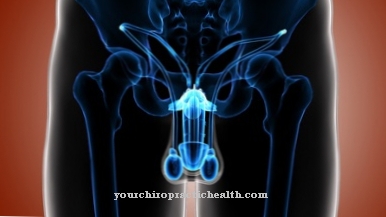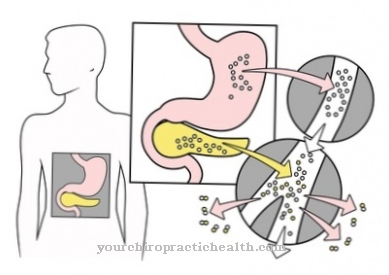Of the Sense of taste is a chemical sense with which the more precise nature of substances, especially food, can be determined. In humans, the sensory cells of taste are in the mouth, mainly on the tongue, but also in the mucous membrane of the mouth and throat.
What is the sense of taste?

The sense of taste, like the sense of smell, is a chemical sense that is used to absorb chemical stimuli from the environment. In contrast to the sense of smell, the sense of taste is a near sense, since it can only absorb stimuli from a substance when it comes into direct contact.
The perception of stimuli takes place via specific chemical components of the substance, which stimulate precisely assigned taste sensory cells. The taste stimulus is then passed on to the brain via taste buds and evaluated there. There is a close connection with simultaneously perceived odor information.
The final taste of a substance is therefore made up of chemical taste and smell information as well as temperature and tactile perceptions from the oral cavity.
Basic flavors recognized in the current state of science are sweet, sour, salty, bitter, and umami (spicy). The fatty flavor is currently being investigated and seems to be confirmed. The specific perception of the flavors metallic, water-based and alkaline is also tested.
Function & task
The receptor cells for taste in humans are located in the taste buds. Each bud contains between 50 and 150 taste cells. 75 percent of the taste buds are distributed on the tongue. The rest is found in the mucous membranes of the oral cavity and throat, on the upper esophagus, the larynx and the soft palate.
Not only do infants and young children have more taste buds than adults. In addition, the buds are also distributed in the middle of the tongue, in the mucous membrane of the lips and cheek, and on the hard palate. With increasing age, the number and distribution of taste buds continues to decrease.
The taste buds are arranged in differently shaped taste papillae on the tongue. Around half of all taste buds in the mouth are located in the back third of the back of the tongue. Wall papillae contain several thousand taste buds in a V-shaped arrangement near the base of the tongue.
Also in the back third of the tongue are the leaf papillae with several hundred taste buds on the edge of the tongue. Fungal papillae are found mainly on the front two-thirds of the tongue. There are up to 400 of them, each containing three to five taste buds.
Each receptor cell can only perceive one particular taste. In the taste buds, however, receptor cells for different flavors are always arranged together. This ensures that every area of the taste buds can react to all possible taste nuances.
This comprehensive ability to react is explained by the vital importance of the sense of taste: it allows people to check the substances they have consumed for their contents before actually taking them.
A sour or bitter taste can indicate immature or fermented or even poisonous food. The flavors sweet, salty, umami and fatty often provide information on essential nutritional components such as carbohydrates, minerals, proteins and fats. This makes it easier to choose what foods are needed and to avoid harmful foods.
If the taste sensory cells are stimulated by the components of an ingested substance, this information is passed on via the taste buds. These combine to form a total of three larger cranial nerves: the facial nerve, the glossopharyngeal nerve and the vagus nerve. These are also designated with the numbers VII, IX and X and guide the taste perceptions into the brain.
You can find your medication here
➔ Medicines against loss of appetiteIllnesses & ailments
Diseases of the sense of taste are medically called dysgeusia. If the sense of taste is quantitatively impaired, a person may be overly sensitive (hypergeusia) or show decreased sensitivity (hypogeusia).
A qualitative impairment is shown in taste sensations without triggering stimuli (phantogeusia) or in altered taste sensations (parageusia). For example, if the taste sensations are changed in such a way that everything tastes unpleasant, the doctor speaks of cakogeusia.
Causes for disorders of the sense of taste can be divided into three areas: On the one hand, dysgeusia can occur due to epithelial damage to the taste buds. The taste buds can be damaged by flu infections or radiation therapy in the head area, among other things.
The taste buds can also be damaged in the case of diabetes mellitus, liver and kidney diseases, hypothyroidism or inflammation of the oral mucosa or tongue.
The ingestion of numerous active ingredients can also affect the sense of taste. These are, for example, penicillamine, chlorhexidine, terbinafine and cytostatics. Cushing's and Sjogren's syndromes are other possible causes of dysgeusia, as is poor oral hygiene.
Damage to cranial nerves VII, IX or X can also be a trigger for a taste disorder. The transmission of taste sensations through these nerves can be disrupted by tumors or inflammatory nerve diseases. A fracture of the skull base or operations on the teeth, ears, tonsils or cervical lymph nodes can also damage the taste buds.
The third area that can affect the sense of taste includes central nervous causes. It affects the so-called "taste pathway", i.e. the path that the transmission of the taste stimulus takes in the central nervous system. Disturbances can arise here from injuries to the brain stem or brain tumors. Certain forms of epilepsy or neurodegenerative diseases such as Alzheimer's can also affect the sense of taste. Some poisonings also affect the sense of taste.
An indirect impairment of the sense of taste also occurs through a disruption of the sense of smell. Even a simple inflammation of the nasal mucous membrane (runny nose) can therefore already cause a clearly perceived deterioration in taste performance. The reason for this is the combined processing of taste and smell information into a complex taste picture in the brain.



























